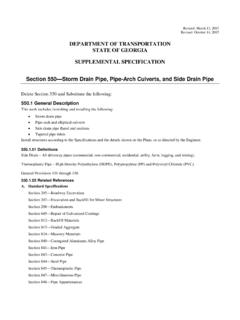Transcription of BURYING ELECTRICAL WIRING - Heights Libraries
1 For do-self or contracted repair BURYING ELECTRICAL WIRING . for garages, landscape lighting and other exterior uses Buried WIRING can be the answer to garage wires that hang too low across your back yard, as well as a way to add post lights, landscape lighting, and the convenience of exterior receptacles. Underground WIRING will not be damaged by weather, wind, tree limbs or the occasional delivery truck, but to protect children and pets from the WIRING (and vice versa) it should be buried properly. Ohio law requires that, before beginning ANY digging project, you contact the Ohio Utilities Protection Service ( ), 1-800-362-2764.
2 You must call at least 48 hours in advance, but no more than 10 working days (excluding weekends and legal holidays), so they can mark where the underground utilities lie on your property. Mark the path you where you plan to dig with white spray paint or white flag stakes prior to their visit. It is not unusual for natural gas pipes or other utilities to be near the surface. By assessing current needs and future use, you can determine how many circuits to include, whether to use conduit or cable, and how heavy an amperage load to plan.
3 Check with your community's ELECTRICAL inspector for any recent changes in local rules, and obtain an ELECTRICAL permit for this project. BURYING 120 volt ELECTRICAL WIRING is really not difficult; digging the trench is the hard part. Try to have as straight a path as possible from the house to the end of the trench. Be aware of the upcoming weather, as you want to dig in relatively dry soil on a fairly pleasant day. If the ground is wet, muddy, or frozen, it makes for a miserable time. A short trench (20 feet or less) can be dug in a day using hand tools, but longer trenches may call for a rented trenching machine to speed things up.
4 The trench does not need to be any wider than the conduit you are BURYING . When digging by hand, a mattock is used to chop into the soil, a digging bar to hack roots and break rocks, and a trenching shovel to clear the trench. These hand tools will still be needed to clean out the trench even if you use a machine. If you place the excavated soil upon a plastic tarp that you've laid alongside the trench, you'll save the grass underneath. If the path of your trench goes underneath a walk or driveway, you may be able to drive an iron pipe to create a passage underneath it, rather than cutting out the asphalt or concrete (see illustrations that follow).
5 Large tree roots can be chopped out (although if too many roots are compromised, the tree may suffer), or it may be possible to route the wires under or through the root mass. (continued). The depth of the trench will be determined by the WIRING method you use. In most cases, you'll probably use conduit (a hollow tube through which you run individual wires). However, if you only need a power supply (without wires to control lights from inside the house,) you can use a direct burial cable, placed in the soil without conduit.
6 Known as UF for underground feeder, the cable has a heavier plastic sheathing than the Romex used inside the house. As with installing indoor WIRING , there are some rules to follow. Most of the rules involve protection of the WIRING from damage. The NEC (National ELECTRICAL Code) requires that UF. cable be placed in a trench at least 24 inches deep. In most communities, you will have to leave the trench open until the inspector arrives to approve the depth. If you are using UF. WIRING , lay 2 x6 treated lumber planks a couple of inches over the wire as the trench is being refilled to prevent a shovel from piercing the WIRING at a later date.
7 Anywhere UF cable is exposed above the soil, it must be protected with conduit. All connections and splices should be done in weatherproof boxes above the soil, to keep water from getting into the connections and causing a short. On the other hand, if you use conduit, the trench needs to be only 18 inches below the surface. Another advantage is that the conduit can carry several wires wires to control garage lights from switches inside the house, as well as the power supply wires. Not all types of conduit can be buried in the soil.
8 EMT ( ELECTRICAL Metallic Tubing). and flexible Raintite are not considered suitable for burial. Aluminum Rigid will corrode away in certain soils, such as clay, or in moist areas. Galvanized steel Rigid conduit requires special tools for making cuts and threading the pipe. That leaves PVC (PolyVinyl Chloride) conduit as the choice for most do-it-yourselfers. With PVC, you'll need only a hacksaw to cut and an utility knife to deburr it. As with other PVC projects, you simply glue pre-formed 90 or 45 ells (elbows) and fittings to the tubing using cleaner and PVC cement, as needed.
9 Code specified that Schedule 40 PVC can be used underground, where the conduit passes through the house, or where it passes inside a lamppost. A thicker-walled PVC. conduit (called Schedule 80) is required where the conduit is exposed above grade (above the soil) on the side of the house and/or garage. While most of the retail building supply companies sell Schedule 40 PVC, they usually do not carry Schedule 80. You will need to locate an ELECTRICAL supply house to purchase Schedule 80. Code also requires that no low-voltage wires be placed in conduit with 120/240-volt circuits.
10 That means that low-voltage wires for garage door controls, intercoms, alarm systems, TV. cables, low-volt landscape lighting, or telephone wires must be in their own conduit (or directly buried), although they can be laid in the same trench next to the higher-voltage conduit. In addition to the basic code requirements, the wires and conduit you use will be determined by the distance between the service panel and the appliances to be powered. Long wire runs can result in a drop in voltage. Let's imagine that you want to build a wood project out in your yard or in a garage workshop, using a 12-amp circular saw.






